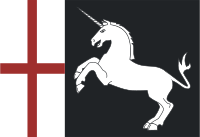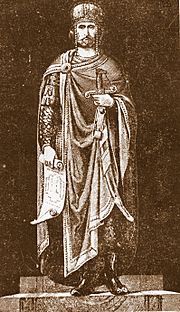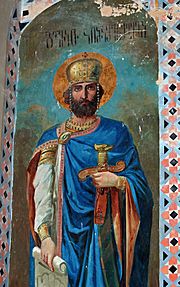David IV of Georgia facts for kids
Quick facts for kids David IVდავით IV |
|
|---|---|
| King of Kings of Georgia | |
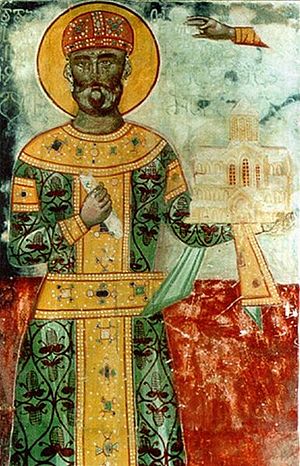
A fresco of King David IV from Gelati Monastery
|
|
| 5th King of Georgia (more...) | |
| Reign | 1089–1125 |
| Predecessor | George II |
| Successor | Demetrius I |
| Born | 1073 Kutaisi |
| Died | 1125 (aged 51–52) Tbilisi |
| Burial | Gelati Monastery |
| Spouse | Rusudan of Armenia Gurandukht of the Kipchaks |
| Issue | Demetrius I Vakhtang George Tamar Kata |
| Dynasty | Bagrationi |
| Father | George II of Georgia |
| Mother | Elene |
| Religion | Georgian Orthodox Church |
| Khelrtva | |
David IV, also known as David the Builder (Georgian: დავით აღმაშენებელი, Davit Aghmashenebeli), was a powerful king of Georgia. He was born in 1073 and ruled from 1089 until his death in 1125. He belonged to the Bagrationi dynasty, a very old royal family.
Many people think David the Builder was the greatest Georgian ruler ever. He helped create the "Georgian Golden Age" – a time of great success and culture. He is famous for pushing the Seljuk Turks out of Georgia. He won a huge battle called the Battle of Didgori in 1121. David also made big changes to the army and how the country was run. This helped him unite Georgia and bring many lands in the Caucasus region under Georgian control. He was a strong supporter of the church and Christian culture. The Georgian Orthodox Church later made him a saint.
Contents
Who Was David the Builder?
David IV is often called "the Builder" because he rebuilt and restored his country. In the Georgian language, his nickname aghmashenebeli means "the Builder" or "the Restorer." This name first appeared in old documents around 1452. Later historians in the 17th and 18th centuries also used it. Some old writings also called him "the Great."
You might see David referred to as David II, III, or IV. This is because different historians numbered Georgian kings in various ways. Today, most scholars in Georgia call him David IV. His earlier namesakes were also important members of the Bagratid royal family.
David's Early Life and Family
David was born around 1073. He became king in 1089 when he was 16 years old. He was the only son of George II of Georgia, who was also a king. His mother's name was Elene. David was named after the famous biblical King David, from whom his family claimed to be descended.
When David was young, Georgia faced a big problem. The Seljuk Turks were invading the country. They had already defeated the Byzantine Empire in a major battle in 1071. This time was known as the "Great Turkish Invasion" in Georgian history. Many parts of Georgia became empty. David's father, King George II, had to make peace and pay tribute to the Seljuk Sultan. Also, powerful Georgian nobles wanted more control for themselves. The old capital city, Tbilisi, was still controlled by Muslim rulers.
Becoming King and Starting Reforms
Seeing his kingdom in trouble, King George II gave the crown to his 16-year-old son David in 1089. Even though he was young, David was already involved in politics. He had the support of his teacher, George of Chqondidi, who was an important church leader.
David IV had a clear plan. He wanted to bring order back to Georgia. He aimed to control the powerful nobles and church leaders. He also wanted to make the government stronger and create a new, powerful army. This army would be able to fight the Seljuk Turks. His goal was to push the Seljuks out of Georgia and then out of the whole Caucasus region.
Between 1089 and 1100, David started small attacks with his loyal troops. He worked to restore order and defeat small enemy groups. He also began to resettle areas that had been emptied by the war. He helped bring life back to important cities.
Taking Back Georgia
David was encouraged by his early successes. He also saw that the Crusades were starting in Palestine. This meant the Seljuks would be busy fighting elsewhere. So, David stopped paying tribute to the Seljuks. He also ended their practice of moving their animals into Georgia for grazing each season.
In 1101, King David captured the Zedazeni fortress. This was a key step in taking back the eastern regions of Kakheti and Hereti. Within the next three years, he freed most of eastern Georgia.
David also dealt with powerful Georgian nobles who opposed him. In 1093, he arrested Liparit Baghvashi, a long-time enemy of the crown. He sent Liparit out of Georgia. After Liparit's son died, David took control of their lands.
By 1099, David IV's power had grown so much that he refused to pay tribute to the Turks. He also rejected a special title from the Byzantine Empire. This showed that Georgia was now strong enough to deal with the Byzantine Empire as an equal.
In 1103, David held a big church meeting called the Ruis-Urbnisi Synod. Here, he removed bishops who opposed him. He also combined two important government jobs into one. This new position was like a prime minister, making the government more efficient.
The next year, David's supporters in eastern Georgia captured the local king, Aghsartan II. This king was loyal to the Seljuk Sultan. David then reunited this area with the rest of Georgia.
Great Military Victories
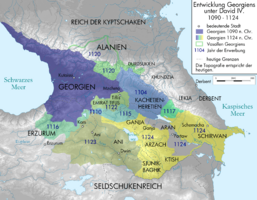
After taking back the Kingdom of Kakheti, David won a battle against a Seljuk army in 1105 at Ertsukhi. This victory helped him capture important fortresses like Samshvilde, Rustavi, Gishi, and Lori between 1110 and 1118.
David faced new challenges. His people had been at war for many years and needed to rebuild their lives. Also, some nobles were still causing problems. The city of Tbilisi was still controlled by the Seljuks. To solve these issues, David made big changes to his army.
He brought 40,000 Kipchak families from the North Caucasus to Georgia between 1118 and 1120. Each Georgian and Kipchak family had to provide one soldier with a horse and weapons. The Kipchaks were settled in different parts of Georgia. They became Christians and quickly became part of Georgian society.
In 1120, David IV moved his army to western Georgia. When the Turks started raiding Georgian lands, he attacked them suddenly. Only a few Seljuk soldiers escaped. King David then entered the neighboring region of Shirvan and took the town of Qabala.
In the winter of 1120–1121, Georgian troops successfully attacked Seljuk settlements in the Transcaucasus region.
Muslim leaders became worried about the growing power of Christian Georgia. In 1121, Sultan Mahmud declared a holy war against Georgia. He gathered a huge army from many Muslim states. The size of this army is debated, but all sources agree it was much larger than David's army of 56,000 men.
However, on August 12, 1121, King David completely defeated this huge enemy army at the Battle of Didgori. This is seen as the greatest military success in Georgian history. The victory at Didgori showed that Georgia was now a major military power. It changed the balance of power in the region, making Georgia the most important country.
After this great victory, David captured Tbilisi in 1122. This city was the last Muslim area left from the Arab occupation. David made Tbilisi the new capital of Georgia. He was a very educated man and believed in treating all religions fairly. He removed special taxes for Muslims and Jews and protected Muslim scholars.
In 1123, David's army freed Dmanisi, the last Seljuk stronghold in southern Georgia. In 1124, David finally conquered Shirvan and took the Armenian city of Ani from its Muslim rulers. This expanded his kingdom's borders all the way to the Araxes river. Armenians welcomed him as a liberator and even joined his army.
David's fair treatment of Muslims and people of other religions set a high standard for tolerance in his diverse kingdom. This was a key part of his rule and of Georgian history and culture.
In early 1123, the Seljuk Sultan Mahmud attacked Shirvan because its ruler, Manuchihr, stopped paying tribute. Manuchihr was influenced by his wife, David's daughter Tamar. Sultan Mahmud captured the city of Shamakhi. In response, in June 1123, David IV attacked and defeated the Sultan again. He then fully conquered Shirvan, taking its cities and fortresses.
David's Death and Legacy
David the Builder died on January 24, 1125. He wanted to be buried under the main gate of the Gelati Monastery. This way, anyone entering his beloved Gelati Academy would step over his tomb first.
He had three children who survived him. His oldest son, Demetrius, became king and continued his father's successful rule. His two daughters were Tamar, who married the ruler of Shirvan, and Kata, who married a Byzantine prince.
Besides his skills as a leader and military commander, King David was also a writer. He wrote "Hymns of Repentance" (Galobani sinanulisani) around 1120. These are powerful poems that show his humility and strong religious faith.
Cultural Achievements
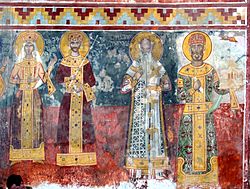
King David the Builder cared deeply about education. He chose talented children and sent them to the Byzantine Empire. There, they learned languages and translated important books into Georgian. Many of these students later became famous scholars.
During David the Builder's time, Georgia had many schools and academies. The Gelati Academy was especially important. It was a major center for culture, learning, and scholarship. Another important center was the academy of Ikalto.
David himself wrote "Hymns of Repentance." These eight poems are like psalms. They show his Christian faith and his deep regret for his sins. In these hymns, David saw himself as similar to the biblical King David, with a special connection to God and his people. His hymns also show the same strong religious passion as the European crusaders of his time. David was a natural ally to them in his fight against the Seljuks.
David's Family
"I David the servant of Jesus sent this book to Holy Mount Sinai and who uses it pray for me"
Document from Saint Catherine's Monastery, 12th century
Marriages
- Rusudan, an Armenian princess (they divorced in 1107)
- Gurandukht, daughter of the Kipchak chief Otrok (married around 1107)
Children
- Demetrius I
- Prince Vakhtang (1112–1138)
- Prince George (1114–1129)
- Princess Rusudan, who married Prince Jadaron of Alania. They had a son named David Soslan, who later married Tamar of Georgia.
- Zurab
- Princess Tamar, who married Shirvanshah Manuchehr III. She later became a nun.
- Princess Kata, who might be the same person as Irene, who married the Byzantine prince Isaakios Comnenus.
Burial Place
There is a tombstone at the entrance of Gelati Monastery that people believe belongs to David IV. It has an old Georgian inscription. Even though we don't have definite proof, this belief has been strong since the mid-1800s. The inscription on the tombstone says: "Christ! This is my resting place for eternity. It pleases me; here I shall dwell."
David's Lasting Impact
David the Builder is a very special figure among the kings of Georgia's "Golden Age." He played a key role in defending the country against the Seljuks.
Today, Georgia has an award called the ""Order of David the Builder"." It is given to people who have made outstanding contributions to the country. This includes those who fought for Georgia's independence and helped its development.
When Mikheil Saakashvili became President of Georgia in 2004, he took his oath at David the Builder's tomb in Gelati Monastery.
The airport in Kutaisi is named David the Builder Kutaisi International Airport after him. The National Defense Academy is also named in his honor.
See also
 In Spanish: David IV de Georgia para niños
In Spanish: David IV de Georgia para niños


